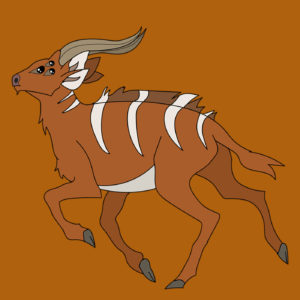Bosh (bawsh)
Boshes were known as swift prarie animals. Some were able to run at bursts as high as 100 km/h (60 mph) or run at a sustained speed of 50 km/h (30 mph). Boshes were found mostly in the deserts, grasslands, and savannas. They tended to live in herds, and eat less coarse, easily digestible plants and leaves. Boshes stood 60–69 cm (1.97–2.26 ft) tall, with an average weight of 35 kg (77 lb). It was characterized by distinctive wide, white bands that runs along the sides of the animal, which separated the brown dorsal parts from the white ventral parts. While both sexes had horns between 10 and 15 cm (3.9 and 5.9 in) long, the males’ were more ribbed and have greater mass. The purpose of the white bands that ran around the side of the animal was to aid in countershading, having ventral body pelage that was more lightly colored that the dorsal surface. This reduced the shadows produced by the animal’s body. The sun shining downward on the animal caused an unequal distribution of light, disrupting the pattern created by its silhouette.
With the gestation period lasting around 160 days, boshes tended to breed in the winter and give birth in the early spring. Before giving birth, the mother would separate herself from the herd to give birth, and then hide the newborn in the thick underbrush outside the herd, returning occasionally to nurse it. This occurred for the first month until the newborn began to eat vegetation, but still relying on nourishment from its mother. Ten days after giving birth, the females bred again, giving birth to two sets of offspring per year. Newborn females could become fertile as early as 27 weeks and gave birth as soon as 70 weeks of age. As herbivorous ruminants, the diet of bosh entirely contains leaves, grasses, and other vegetation. They consumed large amounts of greenery and found a cool place during the day to finish chewing their cuds, remnant wads of food that returned from the stomach (eructation) to be chewed a second time for further digestion.

